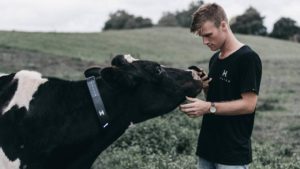 The world’s leading virtual fence company has brought its technology to U.S. ranchers and dairy farmers. Founded in New Zealand, Halter has become the world’s leading virtual fence company in revenue and volume of collars sold and is positioned to deliver its technology to the U.S. market.
The world’s leading virtual fence company has brought its technology to U.S. ranchers and dairy farmers. Founded in New Zealand, Halter has become the world’s leading virtual fence company in revenue and volume of collars sold and is positioned to deliver its technology to the U.S. market.
“Halter technology is a powerful system that helps users precisely manage pasture to lift the performance of the animals grazing it,” says Craig Piggott, Halter Founder and CEO. “For years farmers in New Zealand and Australia have generated significant benefits from utilizing the technology, and we’re excited to bring these same benefits to U.S. cattle ranchers.”
 There are 200,000 cattle under Halter’s management in the United States, New Zealand and Australia, making Halter the largest virtual fencing provider by number of cattle. Halter’s U.S. customers are in California, Oregon, Colorado, Texas and Louisiana, with new customers going live in additional states in the coming months. Halter is quickly growing its U.S.-based team and is hiring dozens of people throughout the States in the coming months.
There are 200,000 cattle under Halter’s management in the United States, New Zealand and Australia, making Halter the largest virtual fencing provider by number of cattle. Halter’s U.S. customers are in California, Oregon, Colorado, Texas and Louisiana, with new customers going live in additional states in the coming months. Halter is quickly growing its U.S.-based team and is hiring dozens of people throughout the States in the coming months.
The Halter app allows users to establish virtual fences and cows are trained to respond to the collar’s sound and vibration cues cues as they approach the virtual fence. Halter collars are lightweight and powered by two small solar cells at the top of the collar which are connected via solar-powered towers on the ranch.
“Ranchers have real-time, 24/7 access to their cattle and pastures to quickly and easily put cattle where the grass is without moving fences or physically herding cattle, offering unparalleled oversight of their herds in real-time” says Piggott.
By enabling more precise pasture management, virtual fencing can play a significant role in regenerative land management. Ranchers can grow and harvest more grass, better protect soils, increase soil carbon sequestration to reduce net emissions, retire unutilized land without reducing stocking rate, and prevent animals from entering protected waterways.
For more information, visit www.halterhq.com
